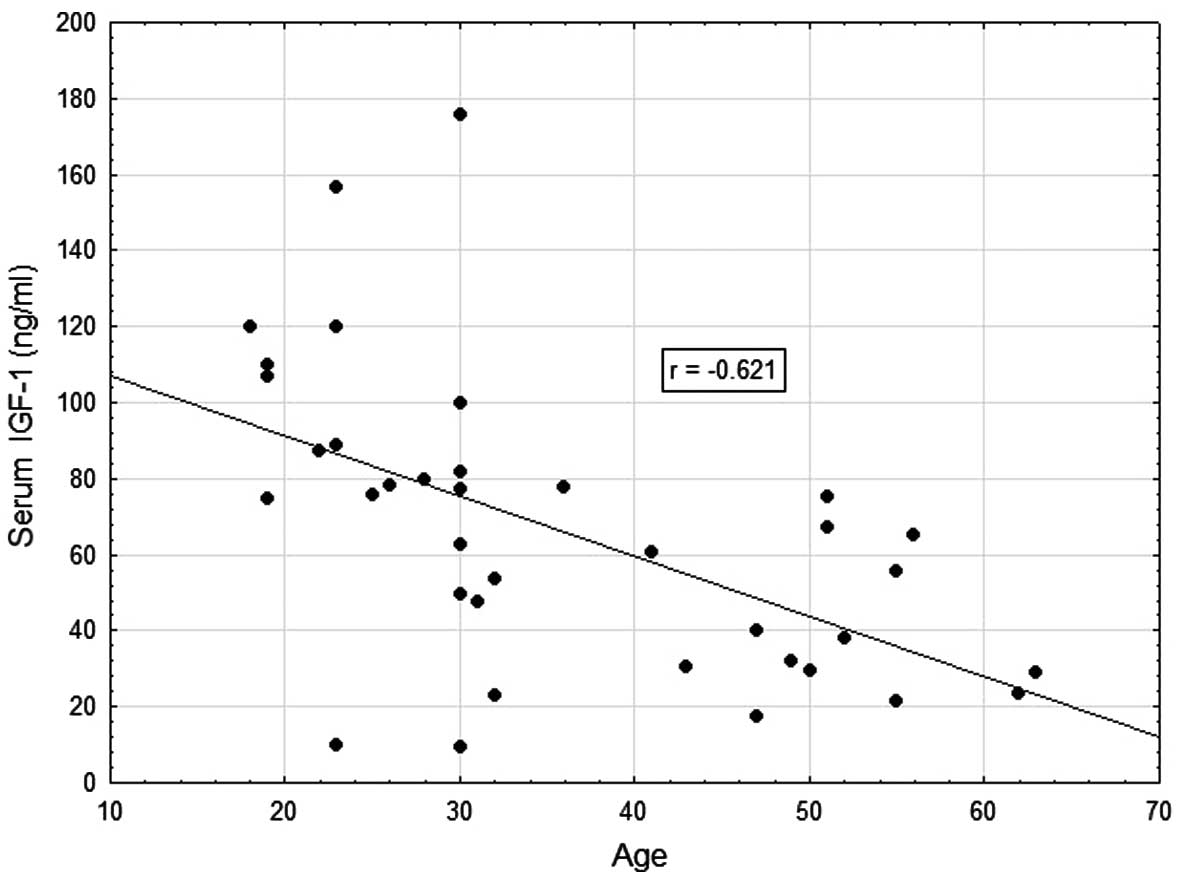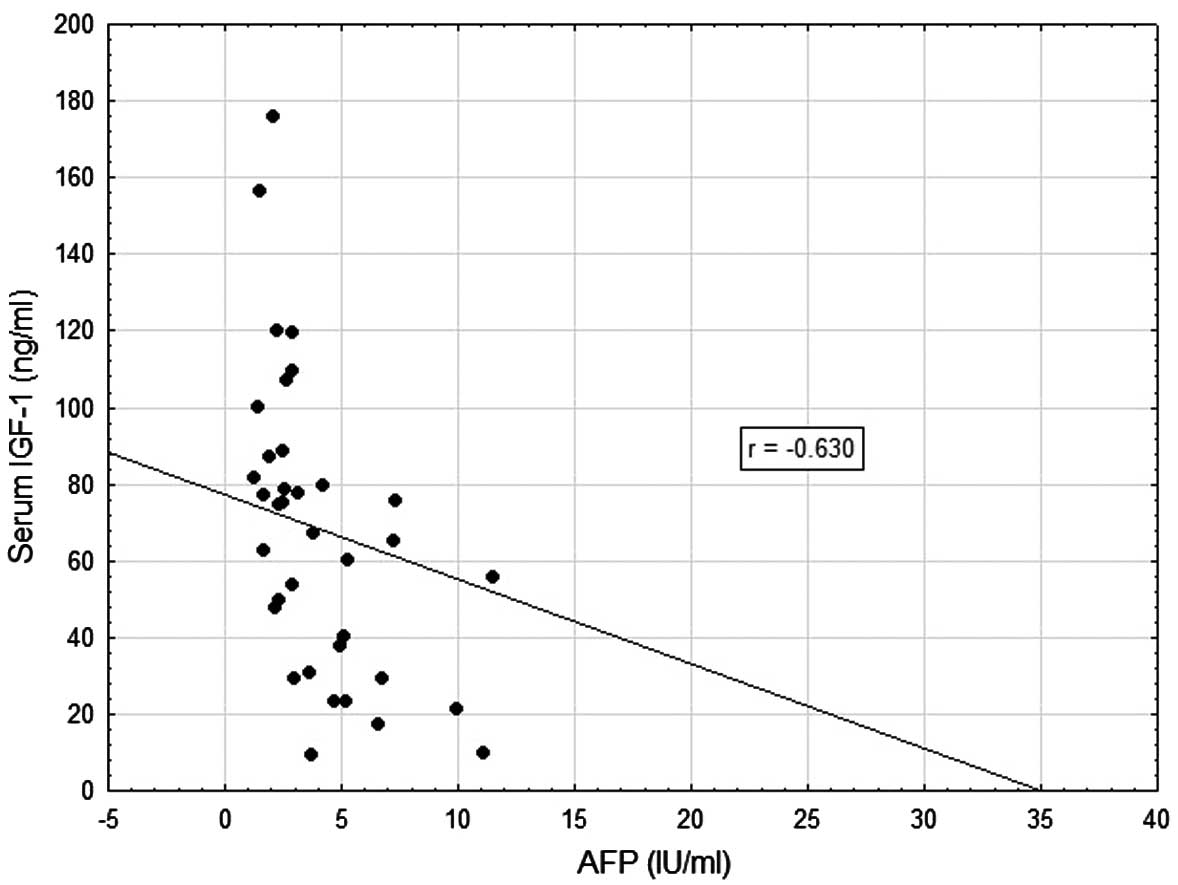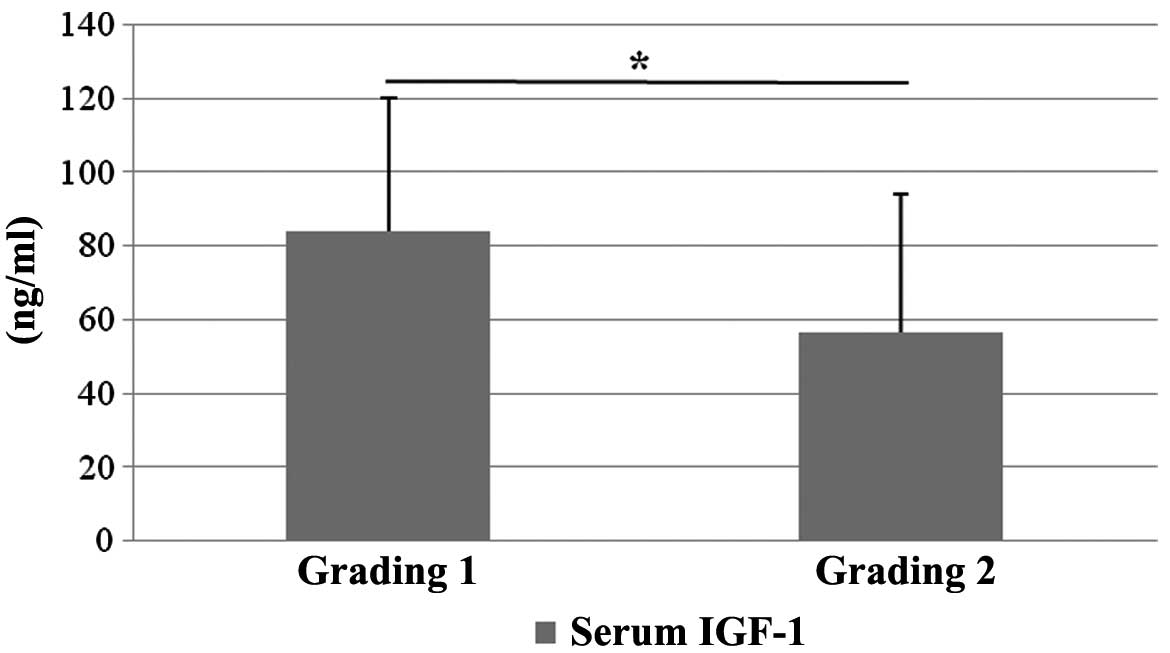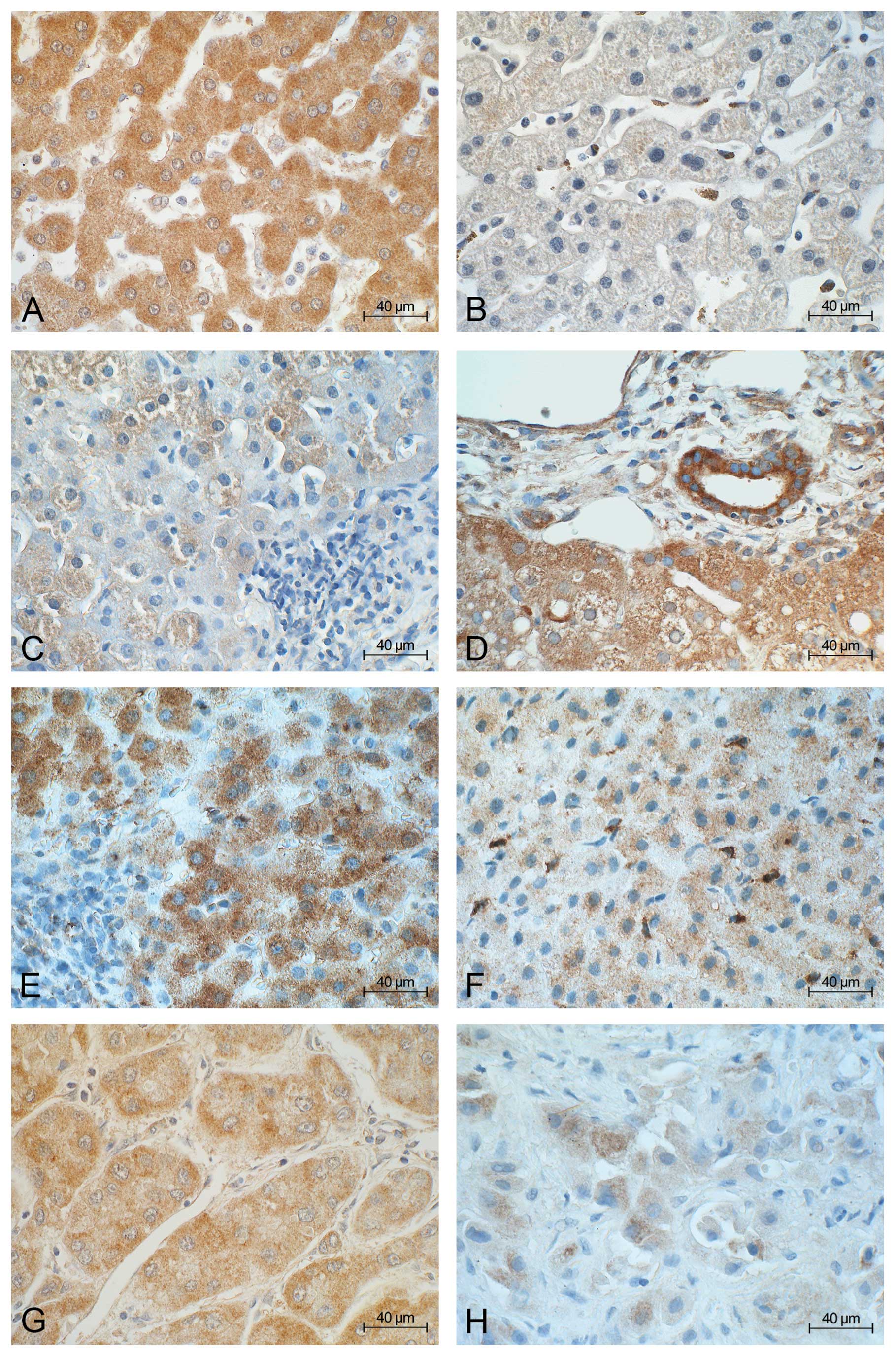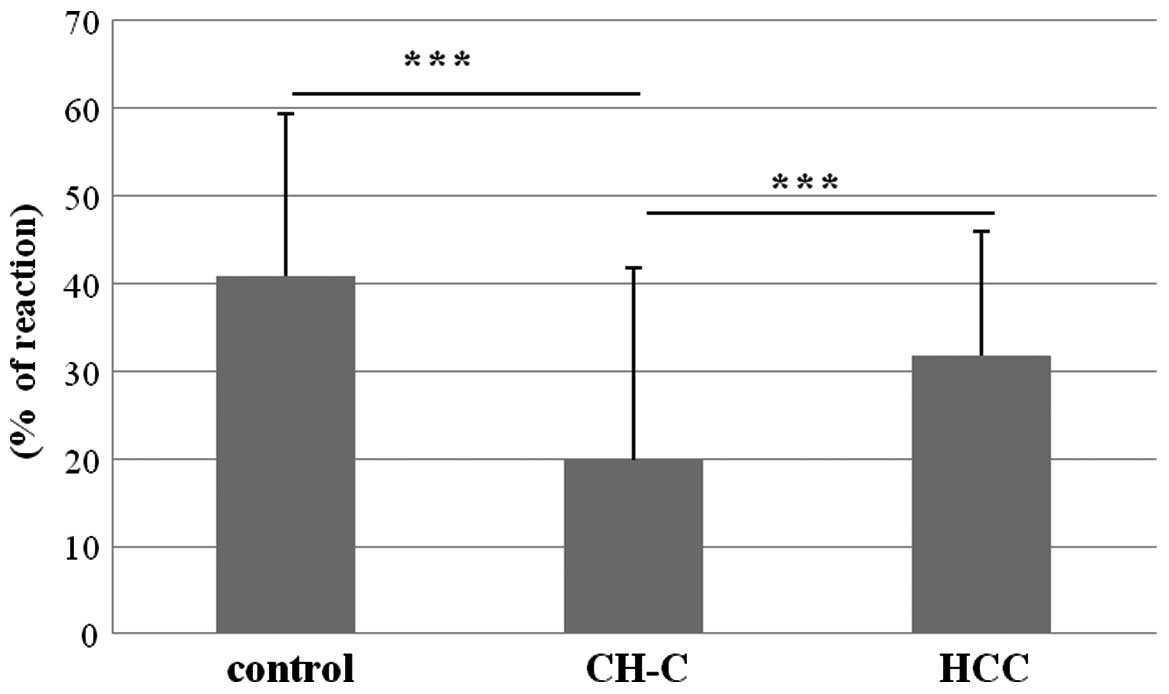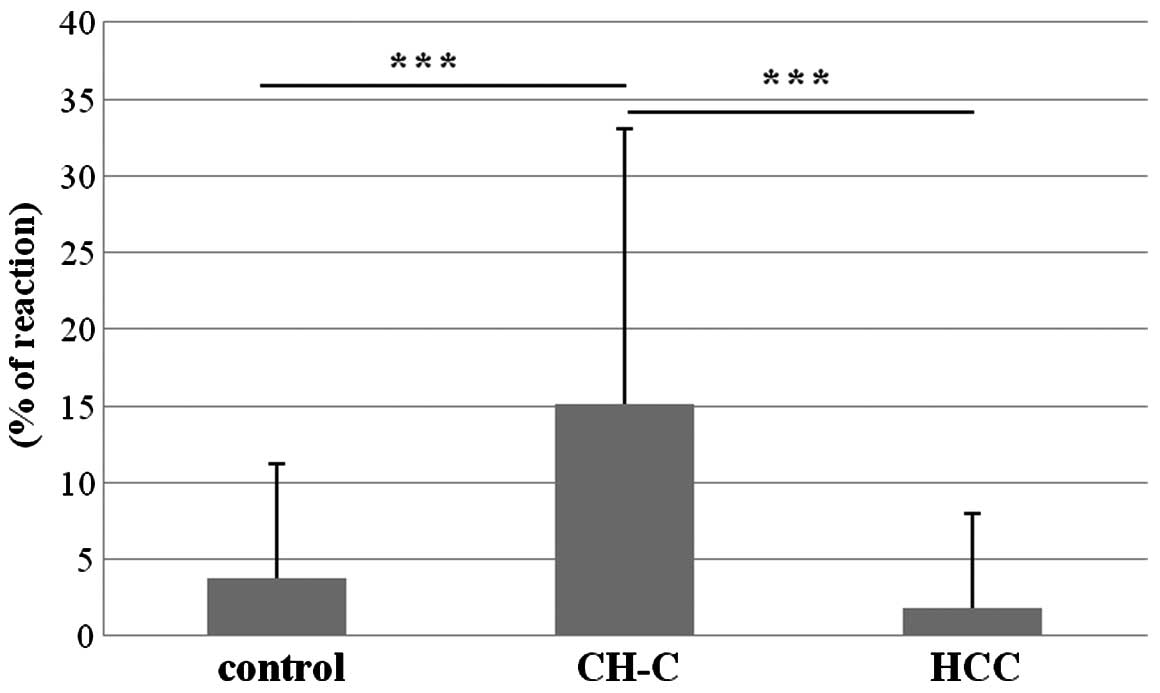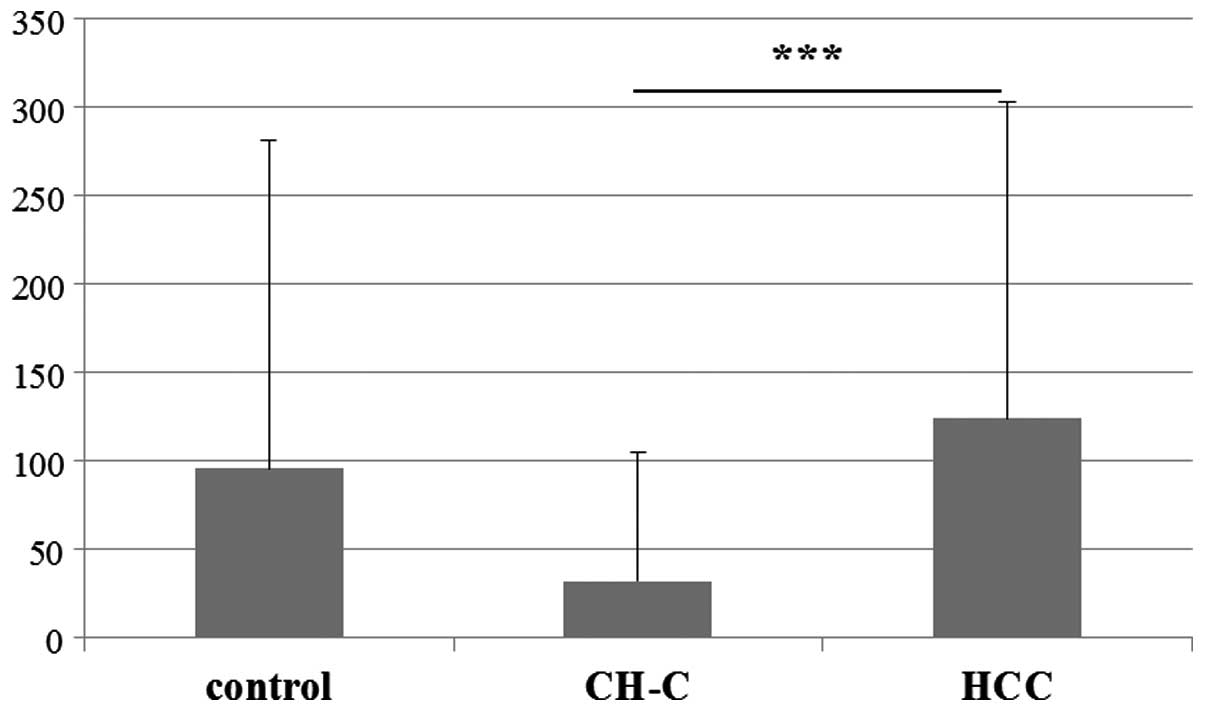The insulin-like growth factor-1 and expression of its binding protein‑3 in chronic hepatitis C and hepatocellular carcinoma
- Authors:
- Published online on: June 19, 2013 https://doi.org/10.3892/or.2013.2546
- Pages: 1337-1345
Abstract
Introduction
Infection with hepatitis C virus (HCV) leads to chronic hepatitis in 60–80% of the patients, with the exception of individuals infected with genotype 2 in Africa, who were found to eliminate the virus more effectively (~50% of the cases). Chronic hepatitis C (CH-C) leads to liver cirrhosis in at least 20% of patients within 20 years after infection and to hepatocellular carcinoma (HCC) in ~25% of HCV-infected patients (1,2). Epidemiological studies showed that HCC develops in 3–6% patients with HCV-related liver cirrhosis and in ~1% of HCV-positive patients manifesting no signs of cirrhosis (3). In HCV-related carcinogenesis, participation of viral proteins themselves used to be accentuated, including at least three HCV proteins: capsid protein (core, protein C) and two non-structural proteins, NS3 and NS5A (4,5). Such products of HCV genome have a direct influence on the disturbance of balance between proliferation and apoptosis of liver cells. These processes are also regulated by liver-derived growth factors, to which insulin-like growth factor (IGF)-1 and -2 belong (6,7). IGF-1 is a secretory protein consisting of a single polypeptide chain with 70 amino acids, which manifests ~50% sequence identity to that of insulin (8,9). In the postnatal period, liver remains the main source of circulating IGF-1 and the protein is produced mainly under effect of growth hormone (GH). Secretion of IGF-1 is also affected by age, gender, genetic factors, nutrition, insulin and disease conditions (9–11). IGF-1 produced in the liver exerts mainly endocrine activity while IGF-1 synthesized by other tissues acts in a para- and/or autocrine manner (8,9). Aside from IGF-1, the system consists of the receptors IGF-1R, IGF-2R, insulin receptor (IR), hybrid dimmers, and at least six high affinity insulin-like growth factor binding proteins (IGFBPs) (7). Most of the circulating IGF-1 is found in a ternary complex with IGF binding protein-3 (IGFBP-3) and the glycoprotein acid-labile subunit (ALS) (11). Binding of IGFBP-3 to IGF-1 prevents the ligand from interacting with the receptors and IGFBP-3 can modulate, both in circulation and in extracellular environment, the extent of IGF-1-dependent effects (12). IGF-1 acts primarily through the binding and the activation of IGF-1R, and ligation of IGF-1R initiates intracellular signalling cascades, involved in mitogenic, cell-survival, anti-apoptotic and transforming activities (13). The IGFBPs may also induce mitogenesis and cell migration (12). Serum concentration of IGF-1 (S-IGF-1) in childhood grows systematically, most rapidly before and during pubescence, when it attains the highest levels, reaching a plateau in early adulthood (10,14). A systematic slow reduction in the IGF-1 level up to the 80th year of age is noted (15). Discordant data are available on a correlation between serum IGFBP-3 (S-IGFBP-3) and age of patients (14,16–18). Concentrations of IGF-1 and IGFBP-3 are stable during the day even if GH, secreted in a pulsatory way, remains to be the principal factor stimulating production and secretion of the two proteins. Levels of IGF-1 are more sensitive to GH control than are the levels of IGFBP-3 (19).
A decreased serum level of both IGF-1 and IGF-2 were found to parallel progression of liver diseases, independently of their etiology (20–23). In liver cirrhosis, lower IGF-1 levels were observed in comparison to control (24,25), as well as its increased concentration following anti-viral therapy (25). A continuous decline in the serum concentration of IGF-1 and IGFBP-3 was observed during progression of cirrhosis and the data correlated significantly with the Child score index (21). Other investigations documented decreased levels of IGF-1 and IGF-2 in chronic liver diseases but the positive correlation with severity of a disease was detected only for IGF-2 (26). The decreased S-IGF-1 level was more pronounced in cases with virus-associated compared to virus-negative HCCs (27). In CH-C, lowered S-IGF-1 levels correlated with severity of liver dysfunction (28) and staging (25). Other investigations found the reduction of S-IGF-1 level to precede by ~9 months the development of HCV-associated HCC (29). There are also data on elevated levels of S-IGF-1 and lowered levels of S-IGFBP-3 as compared to the control in chronic viral hepatitis (HCV or HBV) (30). Lower levels of S-IGFBP-3 were observed in liver steatosis (22), CH-C and liver cirrhosis (18,23,28,31). Serum levels of IGF-1 <30 ng/ml, IGF-2 <200 ng/ml and IGFBP-3 <6 ng/ml indicated a negative prognosis for patients with liver cirrhosis (28). Other studies on patients with already advanced HCC demonstrated markedly lower concentrations of IGF-1 in HCC developed in the course of HCV infection than those noted in hepatitis B virus (HBV)-related HCC (32).
Few studies refer to the role of hepatic IGF-1 and IGFBP-3 expression in chronic hepatitis as prognostic factors related to development of HCC (33,34). In the reports, descriptions of a lowered tissue expression of IGF-1 (33,34) and of a tendency for an increased production of IGF-2 prevail (33). In human HCC samples, IGFBP-3 protein levels were either undetectable or low compared with non-neoplastic liver tissue examined by western blotting (35). The role of the local expression of IGF-1 and IGFBP-3 in the progression of chronic hepatitis to HCC remains unclear. The loss of autocrine/paracrine IGFBP-3 loops is thought to potentially lead to HCC tumor growth (35). Previous results also suggest that IGFBP-3 has growth-inhibitory activity which is independent of its IGF binding properties (36). Particularly little information is available on the coexistence of HCV etiology and tissue expression of IGF-1 and IGFBP-3 as prognostic factors of HCC development (34). Following our earlier studies (37), the aim of this study was to evaluate the levels of S-IGF-1 and S-IGFBP-3 and hepatic expression of both proteins in CH-C and HCC samples. The ratio between IGF-1 and IGFBP-3 was also calculated.
Materials and methods
Patients and tissue material
Studies were performed on serum and liver biopsies obtained from 37 adult patients (18 men and 19 women) aged 18–63 years (mean age 36±14 years) with CH-C (CH-C group) diagnosed at the Department of Infectious Diseases, Poznan University of Medical Sciences. The patients were referred to an anti-viral treatment and had not previously been treated. The group was recruited in 2010–2012. Infections with other hepatotropic viruses (HBV, HCMV, EBV) or other reasons of liver damage were excluded. Patients with diabetes mellitus, kidney failure or any hormone disturbances were not included in the group. HCV infection was confirmed by the presence of anti-HCV antibodies (ELISA method, HCV version 3.0 AXYM System; Abbott) and serum HCV RNA (AMPLICOR HCV™ test, version 2.0; Roche, Mannheim, Germany). Fifteen healthy volunteers (blood donors), age- and gender-matched with the cases, were used as a serum control group (mean age 34±8 years). Plasma levels of IGF-1 were measured by ELISA method (IDS IGF-I ELISA kit; Immunodiagnostic Systems Ltd., Boldon, UK). The quantitative measurement of IGFBP-3 in serum was performed with immunoenzymetric assay (DIAsource IGFBP-3-EASIA Kit; DIAsource Immunoassays S.A., Nivelles, Belgium). Results of both tests were expressed in ng/ml. Liver biopsy and biochemical tests were performed in all cases as a routine procedure prior to antiviral therapy. Based on USG tests and α-fetoprotein (AFP) levels, neoplastic growth (HCC) was not suspected in any patients. Written informed consent was obtained from all patients prior to liver biopsy and approval for the study was granted by the institution’s Ethics Committee. The archival paraffin blocks (without serum samples) with HCC were obtained from 4 patients and tissue microarray panel (n=57) (Cybrdi, Inc., Rockville, MD, USA). Mean age of the HCC group was 51±13 years; 39 patients had histological grading of malignancy G2, 13 patients G3 and 9 patients G1. Only one patient from the HCC group was HCV-positive, in the remaining patients (also in tissue microarray panel) their serological status related to HCV infection remained unknown.
The negative control tissue samples were obtained from livers of serologically HCV-, HBV-, HCMV- and EBV-negative organ donors and normal livers from tissue microarray panel (Cybrdi, Inc.) (n=10) (mean age of the group was 50±16 years). These normal controls were without morphological evidence of pathology. Liver biopsy specimens and all tissue controls were fixed in 10% buffered formalin, embedded in paraffin for purposes of light microscopy and immunocytochemistry.
Histopathological lesions of CH-C patients were analyzed following the classical H&E staining by two pathologists employing a numerical scoring system for the grading (G=0–3) and for the stage of fibrosis (S=0–4) according to the METAVIR Cooperative Study Group (38). Liver steatosis was also semiquantitatively appraised, scoring 0 when no fatty degeneration was noted under a light microscope, and annotating grades 1 or 2 when, respectively, <30% of hepatocytes or 30–70% of hepatocytes were affected (39).
Immunocytochemistry
For immunocytochemistry, 5 μm sections were cut and mounted onto SuperFrost/Plus microscope slides. Monoclonal anti-human IGF-1 and IGFBP-3 antibodies (in a dilution of 1:500 and 1:100, respectively; R&D Systems, Inc.) were employed. The studies followed the classical (strapt)avidin-biotin-peroxidase complex (ABC) technique (40), the details of which were previously described (39). In the case of IGFBP-3, microwave-oven pretreatment for antigen retrieval was used. Internal negative control reactions were based on substituting specific antibodies with normal sera of the respective species in 0.05 M Tris-HCl, pH 7.6, supplemented with 0.1% BSA and 15 mM sodium azide.
Morphometric study using spatial visualization method
Histological slides with IGF-1 and IGFBP-3 positive immunocytochemical expression were examined under the optical Olympus BH-2 Microscope, coupled to a digital camera. Colour microscope images were recorded using ×40 objective (at least 10 fields in every slide), 2,560×1,920 pixels in size using LUCIA Image 5.0 Computer Software, documenting them in jpg format on the computer hard disc. The image analysis was conducted using a technique based on spatial visualization of protein expression in microscope images, elaborated and programmed in the A4D computer software C++ language (41). Results obtained in the two software for image analysis (LUCIA Image 5.0 and A4D) were exported to the format of Microsoft Excel programme. Mean surface area of positive immunocytochemical reaction for IGF-1 and IGFBP-3 per entire surface area of liver parenchyma in every patient and every group of patients was calculated, and expressed in percentage (%), as previously described (37).
Statistical analysis
First, the parameters of descriptive statistics were calculated (arithmetic mean, standard deviation, median value, minimum and maximum values). For statistical analysis of qualitative traits we employed the Mann-Whitney test for unlinked samples. In cases of linked traits, Wilcoxon’s test was applied. Correlations between data rows were determined with the Spearman’s rank correlation index and Kruskal-Wallis test. The relationships or differences were considered significant at the significance level of P≤0.05. The statistical analysis took advantage of the Statistica PL v. 8 software.
Results
Serum concentration of IGF-1 and IGFBP-3 in the CH-C group and control
S-IGF-1 level was significantly lower in CH-C patients compared to controls. Notably, there was no significant difference in S-IGFBP-3 level between the two examined groups. In the CH-C group, a significantly lower ratio S-IGF-1/IGFBP-3 was noted, as compared to the control group (Table I).
Table IMean serum level ± SD and range (in brackets) of IGF-1, IGFBP-3 and IGF-1/IGFBP-3 ratio in the CH-C and the control group. |
Serum concentration of IGF-1 and IGFBP-3 vs. clinicopathological data in the CH-C group
In patients with CH-C, strong negative relationships were demonstrated between concentration of S-IGF-1, on the one hand, and patient age (r=−0.621; P=0.001) and AFP concentration (r=−0.630; P=0.001) on the other (Table II, Figs. 1 and 2). Very weak negative correlations were documented between S-IGF-1, on the one hand, and BMI (r=−0.338; P=0.04), ALT activity (r=−0.339; P=0.04) and concentration of HCV RNA (r=−0.332; P=0.04) on the other (Table II). No significant correlations were detected between S-IGF-1 level, liver steatosis and staging (Table II) and other studied biochemical parameters (AST, levels of total protein, albumins, γ globulins, total bilirubin, glucose, and HOMA-IR) (data not shown). Upon comparison of serum concentration of the two proteins (IGF-1 and IGFBP-3) using also Wilcoxon’s test for various intensities of inflammation (grading), a significantly lower S-IGF-1 was detected in patients with grading 2 (56.56±37.43) as compared to patients with grading 1 (84.28±36.00; P=0.03) (Fig. 3). The group with grading 3 included only 3 patients and, therefore, the respective data could not be compared.
Table IISpearman’s correlation coefficients between IGF-1, IGFBP-3 serum concentration (S) and hepatic expression (H) vs. selected clinical data in the CH-C group. |
Concentration of S-IGFBP-3 in the CH-C group failed to manifest significant relationships with any clinical or pathological variables in the patients (Table II). On the other hand, the S-IGF-1/IGFBP-3 ratio demonstrated pronounced negative correlations with: i) patient age (r=−0.600; P=0.001); ii) AFP concentration (r=−0.626; P=0.001); and weak correlations between iii) S-IGF-1/IGFBP-3 and liver staging (r=−0.348; P=0.03); and iv) a tendency for negative correlation between S-IGF-1/IGFBP-3 and steatosis (r=−0.305; P=0.06) (Table II). A significantly lower S-IGF-1/IGFBP-3 ratio was detected in patients with grading 2 (0.06±0.04) as compared to patients with grading 1 (0.10±0.04; P=0.02) (data not shown).
No significant correlations were detected between IGF-1/IGFBP-3 index and the remaining clinical variables (BMI, ATL, HCV-RNA) (Table II) or with levels of total protein, albumins, γ globulins, total bilirubin, glucose and HOMA-IR (data not shown).
Tissue expression of IGF-1 and IGFBP-3
In control livers, expression of IGF-1 was detected in the cytoplasm of almost all hepatocytes in a high power field (Fig. 4A), and IGFBP-3 was noted mainly in cells of liver sinusoids and, in lower amounts, in hepatocytes as well (Fig. 4B). In all HCV-infected patients, cytoplasmic expression of IGF-1 prevailed in hepatocytes (Fig. 4C) and cholangiocytes (Fig. 4D). IGFBP-3 was detected mainly in hepatocytes (Fig. 4E) but also in cells of liver sinusoids (Fig. 4F). In HCC cells, weak cytoplasmic expression of IGF-1 (Fig. 4G) and IGFBP-3 (Fig. 4H) were demonstrated. Mean hepatic expression of IGF-1 (H-IGF-1) in patients with CH-C was 19.80±22.00% and it was significantly lower than that in the control (40.81±18.53%) and HCC (31.80±14.25%) (Fig. 5). IGFBP-3 tissue (H-IGFBP-3) expression in the CH-C group amounted to 15.10±18.00% and it was significantly higher than that in the control group (3.78±7.40%) and HCC (1.78±6.16) (Fig. 6). The mean H-IGF-1/IGFBP-3 ratio for the CH-C group amounted to 32.20±73.00 and it was significantly lower than that in the HCC group (124.20±179.24) (Fig. 7) but it did not differ from that noted in the control group (95.92±185.52).
Cellular expression of IGF-1 and IGFBP-3 in HCC samples
Expression of both IGF-1 and IGFBP-3 was demonstrated mainly in the cytoplasm of neoplastic cells (Fig. 4G and H). Intensity of two protein expressions manifested extensive individual differences. Quantitative analysis showed that expression of IGF-1 in studied HCC samples (H-IGF-1) was reduced as compared to that in the control (P=0.05) (Fig. 5). Hepatic IGFBP-3 expression in HCC showed no significant differences as compared to the control (P=0.088) (Fig. 6). Also, no significant differences were observed between the hepatic IGF-1/IGFBP-3 ratio in this group of patients and in the control (P=0.230) (Fig. 7). Results of comparative tissue expression in HCC samples and in CH-C were described above (Figs. 5–7). Although it was least pronounced in grading 3 (mean of 24.64±14.14%), expression of IGF-1 in HCC samples manifested no significant differences as compared to the expression in grading 1 (33.36±16.78) or grading 2 (33.61±13.53) (data not shown). Similar differences were related to H-IGFBP-3 expression, which amounted to the mean of 2.32±5.02% in grading 1, 2.19±7.29 in grading 2 and 0.17±0.29 in grading 3, none of which were significantly different. The highest IGF-1/IGFBP-3 index was noted in grading 2 (150.06±217.65), as compared to 91.60±117.07 in grading 1 and 83.50±57.81 in grading 3. Statistical analysis manifested no significant differences related to the degree of histological malignancy. Also, no significant reciprocal correlation was found between expressions of H-IGF-1 and H-IGFBP-3 in HCC samples (r=0.143; P>0.05) (data not shown).
Gender differences in IGF-1 and IGFBP-3 serum levels and liver expression in the CH-C group
Compared to male patients, a significantly higher concentration of S-IGF-1 was detected in women with CH-C but no gender-related differences were detected in concentrations of S-IGFBP-3. Furthermore, no gender-related differences were revealed in tissue expressions of IGF-1 and IGFBP3. A higher S-IGF-1/IGFBP-3 index was found in women, as compared to men, in the patient group, with no gender-related differences in values of IGF-1/IGFBP-3 tissue ratio (Table III).
Table IIIGender differences in serum levels and hepatic expression of IGF-1, IGFBP-3 and IGF-1/IGFBP-3 ratio in the CH-C group. |
Reciprocal correlation between serum concentration and tissue expression of IGF-1 and IGFBP-3 in the CH-C group
No significant relationships were found between concentrations of S-IGF-1 and S-IGFBP-3 (r=−0.172; P>0.05). No significant correlations were found between concentration of S-IGF-1 and hepatic expression of the protein (r=0.251; P>0.005) (data not shown). No significant relationships were detected between levels of S-IGF-1 and H-IGFBP-3 expression (r=0.244; P>0.05). Also, no correlation was detected between expressions of H-IGF-1 and H-IGFBP-3 (r=0.042; P>0.05) (data not shown).
Tissue expression of IGF-1 and IGFBP-3 vs. clinical data in the CH-C group
Liver IGF-1 expression in the CH-C group demonstrated only a weak negative correlation with serum load of HCV RNA (r=−0.360; P=0.04). Expression of H-IGFBP-3 manifested a weak negative correlation with patient BMI (r=−0.433; P=0.01) (Table II). No significant correlations were detected between H-IGF-1 and H-IGFBP-3 expressions, on the one hand, and ALT, AFP, staging and steatosis (Table II) and other biochemical parameters (AST, levels of total protein, albumins, γ globulins, total bilirubin, glucose, and HOMA-IR) on the other (data not shown). Liver IGF-1/IGFBP-3 ratio was directly related to patient BMI (r=0.479; P=0.006) (Table II). The remaining correlations of the index with clinicopathological data proved to be insignificant (data not shown).
In the CH-C group, the hepatic IGF-1/IGFBP-3 (32.20±73.00) ratio was significantly higher than the serum IGF-1/IGFBP-3 ratio (0.07±0.05) (P=0.0001) (data not shown).
Discussion
In the stabilization of circulating IGF-1 levels, the factors involved include age, body nutrition, genetic factors, pregnancy dependent factors and disease conditions. The effect of gender remains insufficiently defined (11). In liver diseases, serum level of IGF-1 is thought to provide a useful marker of the organ function, independently of etiology and patient age (20,24,42). In the CH-C group, our investigations confirmed the negative correlation between concentration of S-IGF-1 and patient age described by other authors (43,44). Moreover, in the CH-C group, we demonstrated that mean S-IGF-1 concentration is higher in women as compared to men. In women and men with normal liver function, a similar situation was described by Yu et al(15). Other authors demonstrated no differences in S-IGF-1 values between men and women (17,45). Reports are also available which suggest slightly lower levels in females as compared to males (11). In our patients with CH-C, serum concentration of IGFBP-3 showed no differences related to age and gender although higher concentrations of S-IGFBP-3 were detected in women as compared to those in men (17). The serum ratio of IGF-1/IGFBP-3 was also higher in the women compared to the men with CH-C in our study and value of the parameter was shown to depend on patient age. This is partially consistent with previous data on healthy adults in whom S-IGFBP3 and ratio of S-IGF-1/IGFBP-3 were age-dependent (14). The relationship between S-IGF-1 concentration and nutritional status is well recognized; in persons with BMI <21 and BMI >29 decreased levels of IGF-1 are noted (11,46). This has been corroborated by our studies on CH-C patients although, in this case, the negative correlation between S-IGF-1 concentration and BMI was very weak. On the other hand, concentration of S-IGFBP-3 manifested no correlation with BMI in our patients with CH-C, which is also consistent with previous literature (47).
In our studies, examination of serum IGF-1 concentration confirmed previous reports which observed lower concentrations in CH-C or in HCV-related liver cirrhosis, as compared to the control (25,26,29,31,32,48). Patients with chronic HCV infection manifested GH insufficiency and persistent GH resistance of hepatocytes, which may also promote a decrease in liver production of IGF-1 (48). In patients with HCV-related cirrhosis, it was even demonstrated that the reduction in IGF-1 level preceded the diagnosis of HCC by 9.3±3.1 months (29). In the present study, we demonstrated significantly lower concentrations of S-IGF-1 in HCV-infected patients with a more intense inflammatory activity (grading 2), as compared to patients with less advanced lesions (grading 1). On the other hand, our study is not in agreement with Lorenzo-Zúñiga et al, who showed in HCV infection that mean IGF-1 values in serum were lower in patients with advanced fibrosis compared to the other patients (25). Absence of such a relationship as related to staging and liver steatosis in our findings most probably reflects the fact that in most of our patients liver steatosis and advancement of fibrosis (staging) were insignificant. On the other hand, a highly pronounced negative correlation was found between concentrations of IGF-1 and AFP in serum of patients with CH-C. This indicates that the two markers of a potential prognostic significance coexist.
In our CH-C group, tissue expression of IGF-1 failed to correlate with concentration of S-IGF-1. However, studies on tissue level have confirmed a significantly lower local expression of IGF-1 as compared to the control. Morali et al(33) also observed a significant reduction in hepatic production of IGF-1 in chronic hepatitis and cirrhosis, although the etiology of respective liver lesions in the studies was unknown. In another study on 34 HCV-infected patients, no significant differences were detected in expression of IGF-1 mRNA as compared to the control (34). As previously described, this study also confirmed a lower than that in the control hepatic expression of IGF-1 in HCC samples (36).
Current investigations have demonstrated no differences in concentration of S-IGFBP-3 in CH-C and in the control. No significant relationships have been detected between serum levels of IGFBP-3 and clinical data. Other studies on the significance of this component of IGF axis in chronic hepatitis were focused mainly on alcohol- or HBV-related liver injuries (28,47). Although the lowered concentration of IGFBP-3 was also documented in patients with CH-C, as compared to the control (30,31), no correlation was detected with the clinicopathological data (grading, staging, transaminase levels) (30) or negative correlations were demonstrated with age and AST activity, and positive correlations with serum albumin and prothrombin concentration (31).
In the present study, mean value of serum IGF-1/IGFBP-3 index was significantly lower in CH-C patients compared to control individuals. Introduction of the parameter permitted us to additionally manifest the relatively more or less pronounced negative correlations of the parameter with several clinical data (age, grading, AFP concentration, staging). In our patients, we were not able to confirm the apparently evident coexistence of lowered S-IGF-1 and serum IGF-1/IGFBP-3 values and the highest IGFBP-3 levels with liver steatosis, reported earlier by other authors in their studies on isolated fatty degeneration of the liver (22) or non-alcoholic fatty liver disease and portal fibrosis (49).
In the present study, quantitative evaluation of tissue IGFBP-3 expression in HCV-infected livers demonstrated a notably significant overexpression of the protein in CH-C patients as compared to the control and HCC patients. Expression of IGFBP-3 protein in livers of patients with CH-C has been demonstrated mainly in hepatocytes while in a normal liver, expression of IGFBP-3 has been demonstrated mainly in Kupffer cells and in portal venous and sinusoidal endothelium, in line with observations of other authors (50). Previous studies in hepatocytes of a normal or cirrhotic human liver observed gene expression of three IGF-1 binding proteins (IGFBP-1, -2 and -3). However, parallel estimations of the three protein concentrations in serum of the patients detected lowered concentrations of IGFBP-3 in cirrhotic liver, as compared to the control (51). The increased local expression of IGFBP-3 in the studied patients with CH-C and the higher hepatic IGF-1/IGFBP-3 index, in comparison to serum IGF-1/IGFBP-3 ratio may suggest a disturbed release of IGFBP-3 from HCV-infected cells. Since no significant correlations have been detected between H-IGFBP-3 and clinical data (except for the weak negative correlation with BMI), the role of local IGFBP-3 overexpression in patients with CH-C requires further studies. In HCC samples, we demonstrated a high value of tissue IGF-1/IGFBP-3 index, a significantly higher one than that detected in the CH-C group. By contrast, Mattera et al detected an augmented serum IGF-1/IGFBP-3 index in patients with HCC, as compared to patients with liver cirrhosis (52). No reciprocal relationships were found between serum concentration and hepatic expression of either IGF-1 or IGFBP-3 in our CH-C group.
In conclusion, we noted lowered serum level of IGF-1 in CH-C as compared to controls. The lowered concentration of S-IGF-1 was linked to an increased inflammatory activity (grading). Tissue expression of IGF-1 was also lower in CH-C, and that of IGFBP-3 protein was increased as compared to healthy liver. In HCC samples, a decreased liver expression of IGF-1 was observed as compared to the control and a higher hepatic ratio of IGF-1/IGFBP-3, but only as compared to the CH-C group. Considering the serum concentration of both studied proteins, concentrations of S-IGF-1 in particular may be accepted as a suitable marker of liver injury in CH-C. Moreover, the studies suggest that inflammatory lesions induced by chronic HCV infection result in a lowered hepatic production of IGF-1, with the resulting decrease in serum IGF-1 concentration. A lowered concentration of S-IGF-1 and H-IGF-1 coexists with other exponents of liver injury in HCV infection. Apart from IGF-1, evaluation of serum IGF-1/IGFBP-3 ratio provides another index allowing to evaluate hepatic function. An increased hepatic expression of IGFBP-3 with no parallel increase in concentration of IGFBP-3 in sera of patients with CH-C may point to a blocked release of IGFBP-3 to circulation as well as to a potential autocrine/paracrine role of the protein in HCV infection. The results indicate a disturbed functioning of IGF axis in HCV infection. Apart from IGF-1 alone and AFP, determination of serum IGF-1/IGFBP-3 ratio may serve as an additional non-invasive marker of a progressive liver injury.
Acknowledgements
The present study was supported by a grant from the Ministry of Education and Science, Warsaw, Poland (no. NN401009437).
References
|
Fattovich G, Stroffolini T, Zagni I and Donato F: Hepatocellular carcinoma in cirrhosis: incidence and risk factors. Gastroenterology. 127:S35–S50. 2004. View Article : Google Scholar : PubMed/NCBI | |
|
Rehermann B and Nascimbeni M: Immunology of hepatitis B virus and hepatitis C virus infection. Nat Rev Immunol. 5:215–229. 2005. View Article : Google Scholar : PubMed/NCBI | |
|
Colombo M: Hepatitis C virus and hepatocellular carcinoma. Semin Liver Dis. 19:263–269. 1999. View Article : Google Scholar : PubMed/NCBI | |
|
Anzola M: Hepatocellular carcinoma: role of hepatitis B and hepatitis C viruses proteins in hepatocarcinogenesis. J Viral Hepat. 11:383–393. 2004. View Article : Google Scholar : PubMed/NCBI | |
|
Kasprzak A and Adamek A: Role of hepatitis C virus proteins (C, NS3, NS5A) in hepatic oncogenesis. Hepatol Res. 38:1–26. 2008. View Article : Google Scholar : PubMed/NCBI | |
|
Alexia C, Fallot G, Lasfer M, Schweizer-Groyer G and Groyer A: An evaluation of the role of insulin-like growth factors (IGF) and of type-I IGF receptor signalling in hepatocarcinogenesis and in the resistance of hepatocellular cells against drug-induced apoptosis. Biochem Pharmacol. 86:1003–1015. 2004. View Article : Google Scholar : PubMed/NCBI | |
|
Kasprzak A and Adamek A: The insulin-like growth factor (IGF) signaling axis and hepatitis C virus-associated carcinogenesis (Review). Int J Oncol. 41:1919–1931. 2012.PubMed/NCBI | |
|
Daughday WH and Rotweien P: Insulin-like growth factors I and II: peptide, messenger ribonucleic acid, and gene structures, serum and tissue concentrations. Endocr Rev. 10:68–91. 1989. View Article : Google Scholar : PubMed/NCBI | |
|
Zarilli R, Bruni CB and Riccio A: Multiple levels of control of insulin-like growth factor gene expression. Mol Cell Endocrinol. 101:R1–R14. 1994. View Article : Google Scholar : PubMed/NCBI | |
|
Juul A, Bang P, Hertel NT, et al: Serum insulin-like growth factor-I in 1030 healthy children, adolescents, and adults: relation to age, sex, stage of puberty, testicular size, and body mass index. J Clin Endocrinol Metab. 78:744–752. 1994.PubMed/NCBI | |
|
Brabant G and Wallaschofski H: Normal levels of serum IGF-I: determinants and validity of current reference ranges. Pituitary. 10:129–133. 2007. View Article : Google Scholar : PubMed/NCBI | |
|
Kostecka Y and Blahovec J: Insulin-like growth factor binding proteins and their functions (minireview). Endocr Regul. 33:90–94. 1999.PubMed/NCBI | |
|
Le Roith D, Bondy C, Yakar S, Liu JL and Butler A: The somatomedin hypothesis: 2001. Endocr Rev. 22:53–74. 2001. | |
|
Elmlinger MW, Kühnel W, Weber MM and Ranke MB: Reference ranges for two automated chemiluminescent assays for serum insulin-like growth factor I (IGF-I) and IGF-binding protein 3 (IGFBP-3). Clin Chem Lab Med. 42:654–664. 2004. View Article : Google Scholar : PubMed/NCBI | |
|
Yu H, Mistry J, Nicar MJ, Khosravi MJ, Diamandis A, van Doorn J and Juul A: Insulin-like growth factors (IGF-I, free IGF-I, and IGF-II) and insulin-like growth factor binding proteins (IGFBP-2, IGFBP-3, IGFBP-6, and ALS) in blood circulation. J Clin Lab Anal. 13:166–172. 1999. View Article : Google Scholar : PubMed/NCBI | |
|
Juul A, Dalgaard P, Blum WF, et al: Serum levels of insulin-like growth factor (IGF)-binding protein-3 (IGFBP-3) in healthy infants, children, and adolescents: the relation to IGF-I, IGF-II, IGFBP-1, IGFBP-2, age, sex, body mass index, and pubertal maturation. J Clin Endocrinol Metab. 80:2534–2542. 1995.PubMed/NCBI | |
|
Mattsson A, Svensson D, Schuett B, Osterziel KJ and Ranke MB: Multidimensional reference region for IGF-I, IGFBP-2 and IGFBP-3 concentrations in serum healthy adults. Growth Horm IGF Res. 18:506–516. 2008. View Article : Google Scholar : PubMed/NCBI | |
|
Raslan HM, Elhosary Y, Ezzat WM, Rasheed EA and Rasheed MA: The potential role of insulin-like growth factor 1, insulin-like growth factor binding protein 3 and bone mineral density in patients with chronic hepatitis C virus in Cairo, Egypt. Trans R Soc Trop Med Hyg. 104:429–432. 2010. View Article : Google Scholar : PubMed/NCBI | |
|
Blum WF, Albertsson-Wikland K, Rosberg S and Ranke MB: Serum levels of insulin-like growth factor I (IGF-I) and IGF binding protein 3 reflect spontaneous growth hormone secretion. J Clin Endocrinol Metab. 76:1610–1616. 1993.PubMed/NCBI | |
|
Wu JC, Daughaday WH, Lee SD, et al: Radioimmunoassay of serum IGF-I and IGF-II in patients with chronic liver diseases and hepatocellular carcinoma with or without hypoglycemia. J Lab Clin Med. 112:589–594. 1988.PubMed/NCBI | |
|
Kratzsch J, Blum WF, Schenker E and Keller E: Regulation of growth hormone (GH), insulin-like growth factor (IGF) I, IGF binding proteins -1, -2, -3 and GH binding protein during progression of liver cirrhosis. Exp Clin Endocrinol Diabetes. 103:285–291. 1995. View Article : Google Scholar : PubMed/NCBI | |
|
Völzke H, Nauck M, Rettig R, Dörr M, Higham C, Brabant G and Wallaschofski H: Association between hepatic steatosis and serum IGF1 and IGFBP-3 levels in a population-based sample. Eur J Endocrinol. 161:705–713. 2009.PubMed/NCBI | |
|
Rehem RN and El-Shikh WM: Serum IGF-1, IGF-2 and IGFBP-3 as a parameters in the assessment of liver dysfunction in patients with hepatic cirrhosis and in the diagnosis of hepatocellular carcinoma. Hepatogastroenterology. 58:949–954. 2011.PubMed/NCBI | |
|
Vyzantiadis T, Theodoridou S, Giouleme O, Harsoulis P, Evgenidis N and Vyzantiadis A: Serum concentrations of insulin-like growth factor-I (IGF-I) in patients with liver cirrhosis. Hepatogastroenterology. 50:814–816. 2003.PubMed/NCBI | |
|
Lorenzo-Zúñiga V, Bartolí R, Masnou H, Montoliu S, Morillas RM and Planas R: Serum concentration of insulin-like growth factor-I (igf-I) as a marker of liver fibrosis in patients with chronic hepatitis C. Dig Dis Sci. 52:3245–3250. 2007.PubMed/NCBI | |
|
Nikolić JA, Todorović V, Bozić M, et al: Serum insulin-like growth factor (IGF)-II is more closely associated with liver disfunction than is IGF-I in patients with cirrhosis. Clin Chim Acta. 294:169–177. 2000.PubMed/NCBI | |
|
Stuver SO, Kuper H, Tzonou A, Lagiou P, Spanos E, Hsieh CC, Mantzoros C and Trichopoulos D: Insulin-like growth factor 1 in hepatocellular carcinoma and metastatic liver cancer in men. Int J Cancer. 87:118–121. 2000. View Article : Google Scholar : PubMed/NCBI | |
|
Wu YL, Ye J, Zhang S, Zhong J and Xi RP: Clinical significance of serum IGF-I, IGF-II and IGFBP-3 in liver cirrhosis. World J Gastroenterol. 10:2740–2743. 2004.PubMed/NCBI | |
|
Mazziotti G, Sorvillo F, Morisco F, et al: Serum insulin-like growth factor I evaluation as a useful tool for predicting the risk of developing hepatocellular carcinoma in patients with hepatitis C virus-related cirrhosis: a prospective study. Cancer. 95:2539–2545. 2002. View Article : Google Scholar | |
|
Okan A, Cömlekçi A, Akpinar H, Okan I, Yeşil S, Tankurt E and Simşek I: Serum concentration of insulin-like growth factor-I and insulin-like growth factor binding protein-3 in patients with chronic hepatitis. Scand J Gastroenterol. 35:1212–1215. 2000. View Article : Google Scholar : PubMed/NCBI | |
|
Raslan H, Ezzat W, Ahmed M and Rasheed E: Insulin growth-factor-1 and insulin-like growth factor binding protein-3 in Egyptian patients with chronic hepatitis C. Arch Med Sci. 3:46–51. 2007. | |
|
Su WW, Lee KT, Yeh YT, Soon MS, Wang CL, Yu ML and Wang SN: Association of circulating insulin-like growth factor 1 with hepatocellular carcinoma: one cross-sectional correlation study. J Clin Lab Anal. 24:195–200. 2010. View Article : Google Scholar : PubMed/NCBI | |
|
Morali G, Shitrit AB, Eran M, Freier S, Reinus C and Braverman D: Hepatic production of insulin-like growth factors in normal and diseased liver. Hepatogastroenterology. 52:1511–1515. 2005.PubMed/NCBI | |
|
Stefano JT, Correa-Giannella ML, Ribeiro CMF, Alves VAF, Massarollo PCB, Machado MCC and Giannella-Neto D: Increased hepatic expression of insulin-like growth factor-I receptor in chronic hepatitis C. World J Gastroenterol. 28:3821–3828. 2006.PubMed/NCBI | |
|
Huynh H, Chow PKH, Ooi LLP and Soo KC: A possible role for insulin-like growth factor-binding protein-3 autocrine/paracrine loops in controlling hepatocellular carcinoma cell proliferation. Cell Growth Differ. 13:115–122. 2002. | |
|
Clemmons DR: Insulin-like growth factor binding proteins and their role in controlling IGF actions. Cytokine Growth Factor Rev. 8:45–62. 1997. View Article : Google Scholar : PubMed/NCBI | |
|
Kasprzak A, Adamek A, Przybyszewska W, et al: Expression of IGF-1 and viral proteins (C, NS3, NS5A) in the livers of patients with chronic HCV infection. Adv Clin Exp Med. 20:263–273. 2011. | |
|
Bedossa P and Poynard T: An algorithm for the grading of activity in chronic hepatitis C. The METAVIR Cooperative Study Group. Hepatology. 24:289–293. 1996. View Article : Google Scholar : PubMed/NCBI | |
|
Kasprzak A, Adamek A, Biczysko W, et al: Intracellular expression of the proliferative marker Ki-67 and viral proteins (NS3, NS5A and C) in chronic, long lasting hepatitis C virus (HCV) infection. Folia Histochem Cytobiol. 45:357–366. 2007.PubMed/NCBI | |
|
Hsu SM, Raine L and Fanger H: Use of avidin-biotin-peroxidase complex (ABC) in immunoperoxidase techniques: a comparison between ABC and unlabeled antibody (PAP) procedures. J Histochem Cytochem. 29:577–580. 1981. View Article : Google Scholar : PubMed/NCBI | |
|
Kaczmarek E and Strzelczyk R: From two to three-dimensional visualisation of structures in light and confocal microscopy - applications for biomedical studies. Current Issues on Multidisciplinary Microscopy Research and Education. Mendez-Vilas A and Labajos-Broncano L: (FORMATEX microscopy book series no II). Formatex Research Centre; Badajoz: pp. 289–295. 2005 | |
|
Mahdy KA, Ahmed HH, Mannaa F and Abdel-Shaheed A: Clinical benefits of biochemical markers of bone turnover in Egyptian children with chronic liver diseases. World J Gastroenterol. 13:785–790. 2007. View Article : Google Scholar : PubMed/NCBI | |
|
Aimaretti G, Boschetti M, Corneli G, et al: Normal age-dependent values of serum insulin growth factor-I: results from a healthy Italian population. J Endocrinol Invest. 31:445–449. 2008. View Article : Google Scholar : PubMed/NCBI | |
|
Andreassen M, Nielsen K, Raymond I, Kristensen LØ and Faber J: Characteristics and reference ranges of insulin-like growth factor-I measured with a commercially available immunoassay in 724 healthy adult Caucasians. Scand J Clin Lab Invest. 69:880–885. 2009. View Article : Google Scholar : PubMed/NCBI | |
|
Rosario PW: Normal values of serum IGF-1 in adults: results from a Brazilian population. Arq Bras Endocrinol Metabol. 54:477–481. 2010. View Article : Google Scholar : PubMed/NCBI | |
|
Holmes MD, Pollak MN and Hankinson SE: Lifestyle correlates of plasma insulin-like growth factor I and insulin-like growth factor binding protein 3 concentrations. Cancer Epidemiol Biomarkers Prev. 11:862–867. 2002. | |
|
Colakošlu O, Taşkiran B, Colakoğlu G, Kizildağ S, Ari Ozkan F and Unsal B: Serum insulin like growth factor-1 (IGF-1) and insulin growth factor binding protein-3 (IGFBP-3) levels in liver cirrhosis. Turk J Gastroenterol. 18:245–249. 2007. | |
|
Plöckinger U, Krüger D, Bergk A, Weich V, Wiedenmann B and Berg T: Hepatitis-C patients have reduced growth hormone (GH) secretion which improves during long-term therapy with pegylated interferon-alpha. Am J Gastroenterol. 102:2724–2731. 2007.PubMed/NCBI | |
|
Ichikawa T, Nakao K, Hamasaki K, et al: Role of growth hormone, insulin-like growth factor 1 and insulin-like growth factor-binding protein 3 in development on non-alcoholic fatty liver disease. Hepatol Int. 1:287–294. 2007. View Article : Google Scholar : PubMed/NCBI | |
|
Arany E, Afford S, Strain AJ, Winwood PJ, Arthur MJ and Hill DJ: Differential cellular synthesis of insulin-like growth factor binding protein-1 (IGFBP-1) and IGFBP-3 within human liver. J Clin Endocrinol Metab. 79:1871–1876. 1994.PubMed/NCBI | |
|
Ross RJM, Chew SL, D’Souza Li L, et al: Expression of IGF-I and IGF-binding protein genes in cirrhotic liver. J Endocrinol. 149:209–216. 1996. View Article : Google Scholar : PubMed/NCBI | |
|
Mattera D, Capuano G, Colao A, Pivonello R, Manguso F, Puzziello A and D’Agostino L: Increased IGF-I:IGFBP-3 ratio in patients with hepatocellular carcinoma. Clin Endocrinol (Oxf). 59:699–706. 2003. View Article : Google Scholar : PubMed/NCBI |



